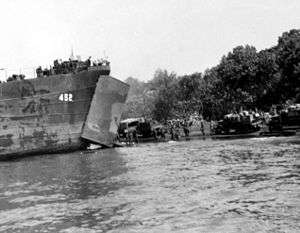USS LST-452
 USS LST-452, and other LSTs are unloading troops and equipment of part of the 9th Australian Division, under the command of Major-General G.F. Wooten landing at Lae, New Guinea, 4 September 1943. | |
| History | |
|---|---|
| Name: | LST-452 |
| Ordered: | as a Type S3-M-K2 hull, MCE hull 972[1] |
| Builder: | Kaiser Shipbuilding Company, Vancouver, Washington |
| Yard number: | 156[1] |
| Laid down: | 20 July 1942 |
| Launched: | 10 October 1942 |
| Commissioned: | 16 January 1943 |
| Decommissioned: | 12 June 1946 |
| Identification: |
|
| Honors and awards: |
|
| Fate: | sold, 5 December 1947 |
| Status: | unknown |
| General characteristics [2] | |
| Class and type: | LST-1-class tank landing ship |
| Displacement: |
|
| Length: | 328 ft (100 m) oa |
| Beam: | 50 ft (15 m) |
| Draft: |
|
| Installed power: |
|
| Propulsion: |
|
| Speed: | 12 kn (22 km/h; 14 mph) |
| Range: | 24,000 nmi (44,000 km; 28,000 mi) at 9 kn (17 km/h; 10 mph) while displacing 3,960 long tons (4,024 t) |
| Boats & landing craft carried: | 2 x LCVPs |
| Capacity: | 1,600–1,900 short tons (3,200,000–3,800,000 lb; 1,500,000–1,700,000 kg) cargo depending on mission |
| Troops: | 16 officers, 147 enlisted men |
| Complement: | 13 officers, 104 enlisted men |
| Armament: |
|
| Service record | |
| Operations: |
|
| Awards: | |
USS LST-452 was a United States Navy LST-1-class tank landing ship used in the Asiatic-Pacific Theater during World War II.
Construction
LST-452 was laid down on 20 July 1942, under Maritime Commission (MARCOM) contract, MC hull 972, by Kaiser Shipyards, Vancouver, Washington; launched on 10 October 1942; and commissioned on 16 January 1943.[3]
Service history
During the war, LST-452 was assigned to the Pacific Theater of Operations. She took part in the Eastern New Guinea operations, the Lae occupation in September 1943, the Finschhafen occupation in September 1943, and the Saidor occupation in January 1944; the Bismarck Archipelago operations, the Cape Gloucester, New Britain, landings from December 1943 through February 1944, and the Admiralty Islands landings in March 1944; the Hollandia operation in April and May 1944; the Western New Guinea operations, the Biak Islands operation in May and June 1944, the Cape Sansapor operation in July and August 1944, and the Morotai landing in September 1944; the Leyte landings in October 1944; the Lingayen Gulf landings in January 1945; and the Balikpapan operation in June and July 1945.[3]
Post-war service
Following the war, LST-452 saw service in China until mid-May 1946. She returned to the United States and was decommissioned on 12 June 1946, and struck from the Navy list on 3 July, that same year. On 5 December 1947, the ship was sold to Bosey, Philippines.[3]
Honors and awards
LST-452 earned seven battle stars for her World War II service.[3]
Notes
- Citations
Bibliography
Online resources
- "LST-452". Dictionary of American Naval Fighting Ships. Naval History and Heritage Command. Retrieved 2 April 2017.

- "Kaiser Vancouver, Vancouver WA". www.ShipbuildingHistory.com. 27 November 2010. Retrieved 2 April 2017.
- "USS LST-452". Navsource.org. 10 March 2017. Retrieved 2 April 2017.
External links
| Wikimedia Commons has media related to USS LST-452. |
- Photo gallery of USS LST-452 at NavSource Naval History